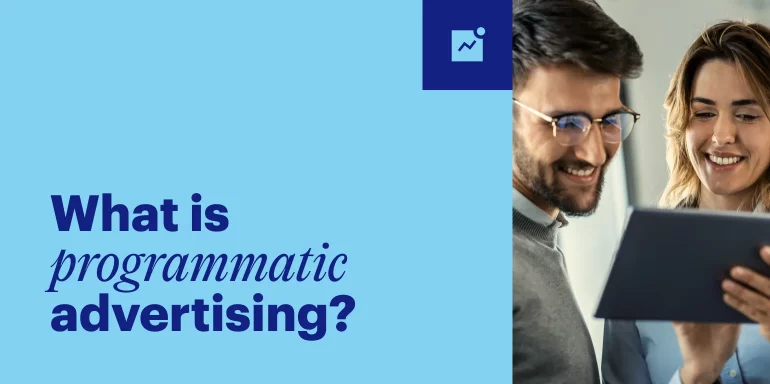Looking to get your ads seen by the right eyes at the right time? Programmatic advertising can optimize your ad targeting and timing to precision using detailed data and smart algorithms. But how exactly does programmatic advertising work? And how does it differ from traditional display advertising or programmatic media buying?
Read on to learn all you need to know about programmatic advertising.
What is programmatic advertising?
Programmatic advertising, also known as programmatic marketing or programmatic media buying, involves purchasing ad space via software and relying on complex algorithms to deliver advertisements contextually.
While the traditional media buying process relies on manual negotiations and purchasing ad space directly from publishers, programmatic advertising uses automation to help advertisers target specific audience segments, determine the optimal ad placement, and bid on ad impressions across various digital platforms.
By the end of 2028, Statista Research Department anticipates programmatic ad spending will reach $778.85 billion.
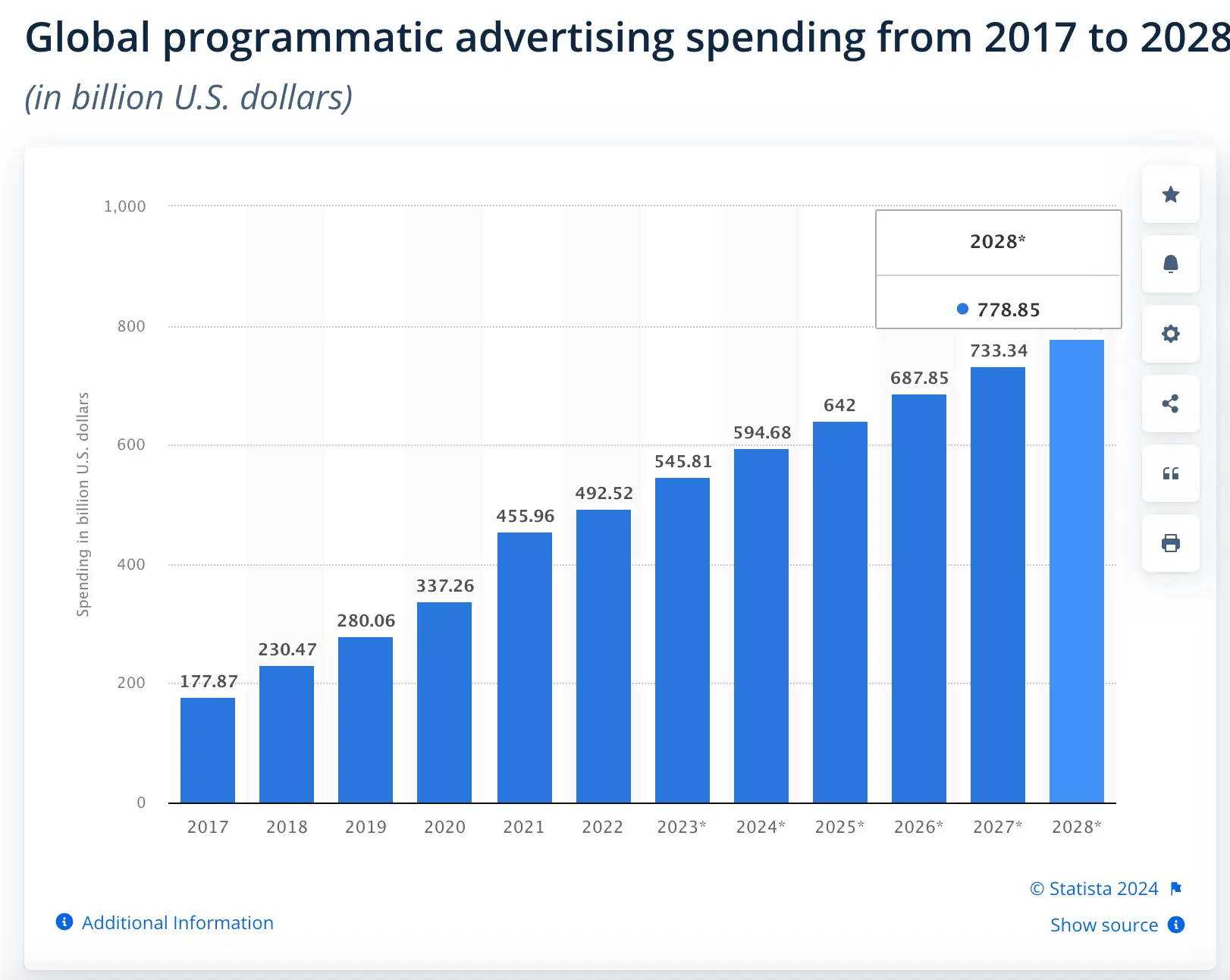
How programmatic advertising works
Here’s a quick rundown of how programmatic advertising works:
- An advertiser sets up a campaign, defining the target audience and budget.
- When a user visits a website or app with ad space, information about the page and user is sent to an ad exchange.
- Advertisers’ algorithms analyze this information to decide if the user fits their target audience.
- If there’s a match, advertisers bid for the ad space in real-time auctions.
- The highest bidder’s ad is then instantly displayed to the user.
This process happens in milliseconds, ensuring that ads are shown to relevant audiences almost instantaneously as they surf the web.
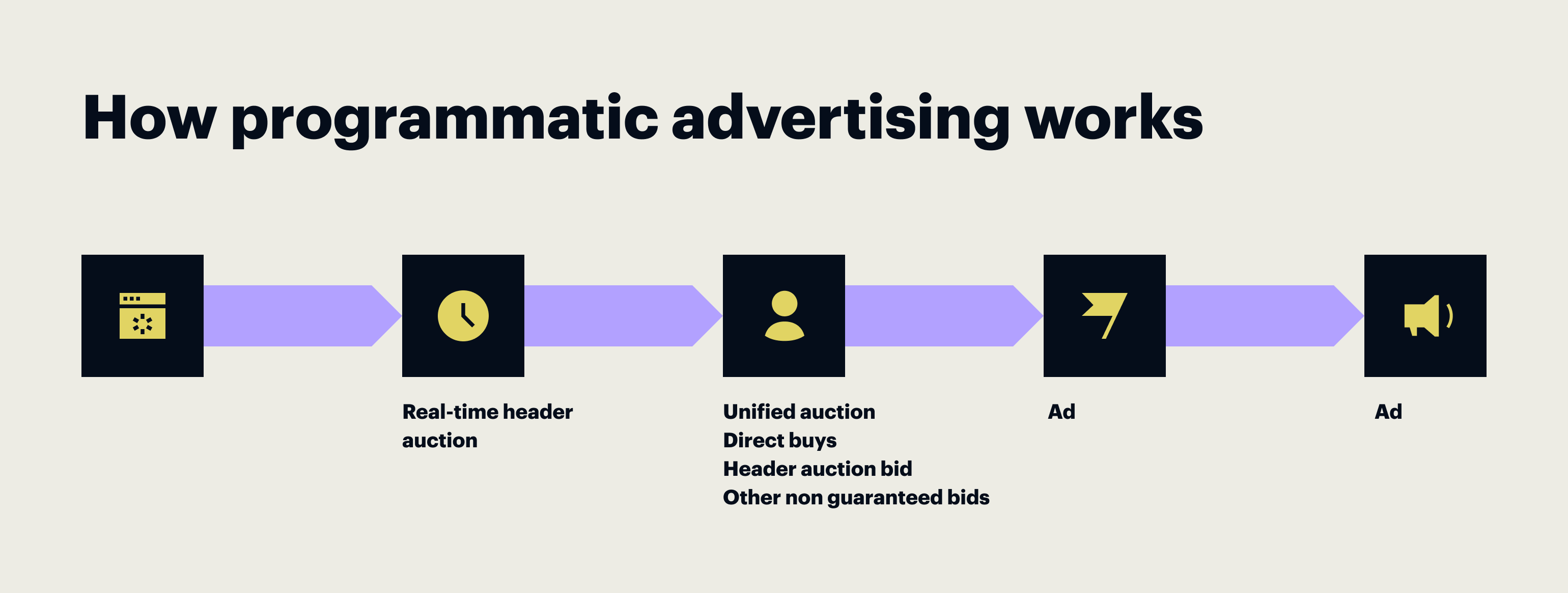
What is programmatic media buying, and how is it different from programmatic advertising?
Programmatic media buying focuses specifically on purchasing, while programmatic advertising involves planning, buying, optimizing, and analyzing digital advertising campaigns using automated technology.
Let’s take a look at the differences between these concepts:
- Programmatic media buying is the automated process of purchasing ad space, utilizing data and algorithms to serve ads to the right user at the right price. It uses algorithms and software to streamline the buying process, replacing traditional manual negotiations and paperwork. Through programmatic buying, advertisers can target specific audiences with precision and efficiency across various digital platforms, including websites, social media, and mobile apps.
- Programmatic media advertising entails using automated technology for media buying, which differs from traditional manual digital advertising methods. While programmatic media buying is a subset of programmatic advertising, the latter encompasses a broader range of activities beyond purchasing ad space. Programmatic ad buying represents a comprehensive approach to digital advertising, leveraging automation and data-driven insights to optimize campaign performance and maximize ROI.
The table below provides an overview of programmatic media buying and programmatic advertising, highlighting their respective focuses and functionalities within the realm of digital marketing:
| Aspect | Programmatic Media Buying | Programmatic Advertising |
| Automation | Automates the process of purchasing digital ad space | Automates the entire process of digital advertising |
| Scope | Focuses specifically on purchasing ad inventory | Encompasses planning, buying, optimizing, analyzing |
| Targeting | Utilizes data to target specific audience segments | Utilizes data for audience targeting and ad optimization |
| Real-Time Bidding (RTB) | Involves bidding on ad impressions in real-time auctions | Incorporates RTB as part of the automated buying process |
| Ad Placement | Places ads on selected platforms or websites | Manages ad placement, creative optimization, and campaign management |
| Optimization | Limited to optimizing the buying process | Involves dynamic ad creative optimization and campaign management |
| Budget Allocation | Focuses on budget allocation for ad purchases | Manages overall campaign budget allocation |
| Performance Tracking | Tracks ad performance metrics post-placement | Tracks campaign performance across multiple metrics |
| Personalization | Limited personalization based on target audience | Enables dynamic content personalization and ad serving |
| Efficiency | Streamlines ad buying process for efficiency | Maximizes efficiency across entire ad campaign lifecycle |
How is programmatic advertising different from display advertising?
Programmatic advertising uses automated technology and algorithmic tools for media buying, while display advertising refers to the format of the ad and where it appears—visual banner ads placed on a network of websites.
Both programmatic and display advertising serve specific purposes in your marketing funnel. Programmatic advertising is about the ‘how’: it directs the method by which marketers acquire or sell digital ad space. On the other hand, display advertising is about the ‘what’ and ‘where’ – the type of ad displayed and its placement.
- Programmatic advertising involves buying ad space based on data and algorithms and serving ads to the right user at the right time and price, while display advertising is about using particular ad formats. The ads are then published on display ad networks. Programmatic ads encompass various ad formats, including display, video, mobile, and social, while display advertising is confined to specific visual formats and locations within an ad network.
- Display advertising aims to deliver general advertisements and brand messages to site visitors. Thus, they are good for reminding about your brand’s existence, not so much for conversions or clicks due to their delivery. Display advertising operates within a specific ad network. You can choose the websites or platforms where you want their ads displayed, focusing on spaces where you believe your target audience is most likely to be found. While you can purchase display advertising programmatically, traditional methods also work for traditional ads like TV commercials and billboards.
The chart below compares programmatic advertising and display advertising, highlighting their respective focuses, functionalities, and roles in a digital marketing strategy:
| Aspect | Programmatic advertising | Display advertising |
| Technology | Utilizes automated technology and algorithms for media buying | Focuses on the format and placement of visual ads on websites |
| Buying process | Involves automated buying based on data and algorithms, targeting the right user at the right time and price | Involves purchasing ad space within specific ad networks |
| Ad formats | Encompasses various formats including display, video, mobile, and social media | Limited to specific visual formats within ad networks |
| Main purpose | Primarily aimed at driving conversions and clicks by targeting the right audience with personalized ads | Focuses on delivering general advertisements and brand messages to site visitors |
| Advertising network | Operates across various digital platforms and ad exchanges | Limited to specific ad networks where ads are displayed |
| Targeting | Targets specific audience segments based on data insights | Targets general site visitors within chosen ad networks |
| Flexibility | Offers flexibility in ad placement and optimization through real-time bidding | Limited flexibility in ad placement and optimization |
| Marketing funnel role | Focuses on the ‘how’ – the method of acquiring or selling digital ad space | Focuses on the ‘what’ and ‘where’ – the type of ad and its placement |
| Emphasis on brand existence | Effective for driving conversions and clicks due to personalized targeting | Good for reminding about brand existence, less effective for conversions or clicks |
| Traditional advertising methods | Works for digital platforms and traditional methods like TV commercials and billboards | Primarily utilized for digital display advertising |
Programmatic advertising platforms
You can choose from the following programmatic advertising platforms based on your campaign goals and your audience’s browsing habits:
Sell-side platforms
Sell-side platforms, or SSPs, are platforms for publishers looking to sell their ad inventory. SSPs let publishers efficiently manage their ad space and optimize their revenue potential.
These perform well in automating the selling process of digital ad space, which is good news for publishers. For instance, a news website with high traffic volumes might use platforms SmartyAds or Xandr to ensure their ad space is sold at the best possible price. For publishers, such platforms are perfect for streamlining ad space management and increasing revenues. For marketers, it is a sure and quick way to reach their crowd.
Demand-side platforms
Demand-side platforms like The Trade Desk, MediaMath, or Adform, automate the purchasing of ad inventory, making it easier and more efficient for advertisers to reach their target audience.
For example, an apparel e-commerce business might use The Trade Desk to bid for and secure ad space on popular fashion blogs, reaching potential customers who are likely interested in their products. The business can then execute targeted, data-driven campaigns across multiple channels and formats with the help of demand-side platforms.
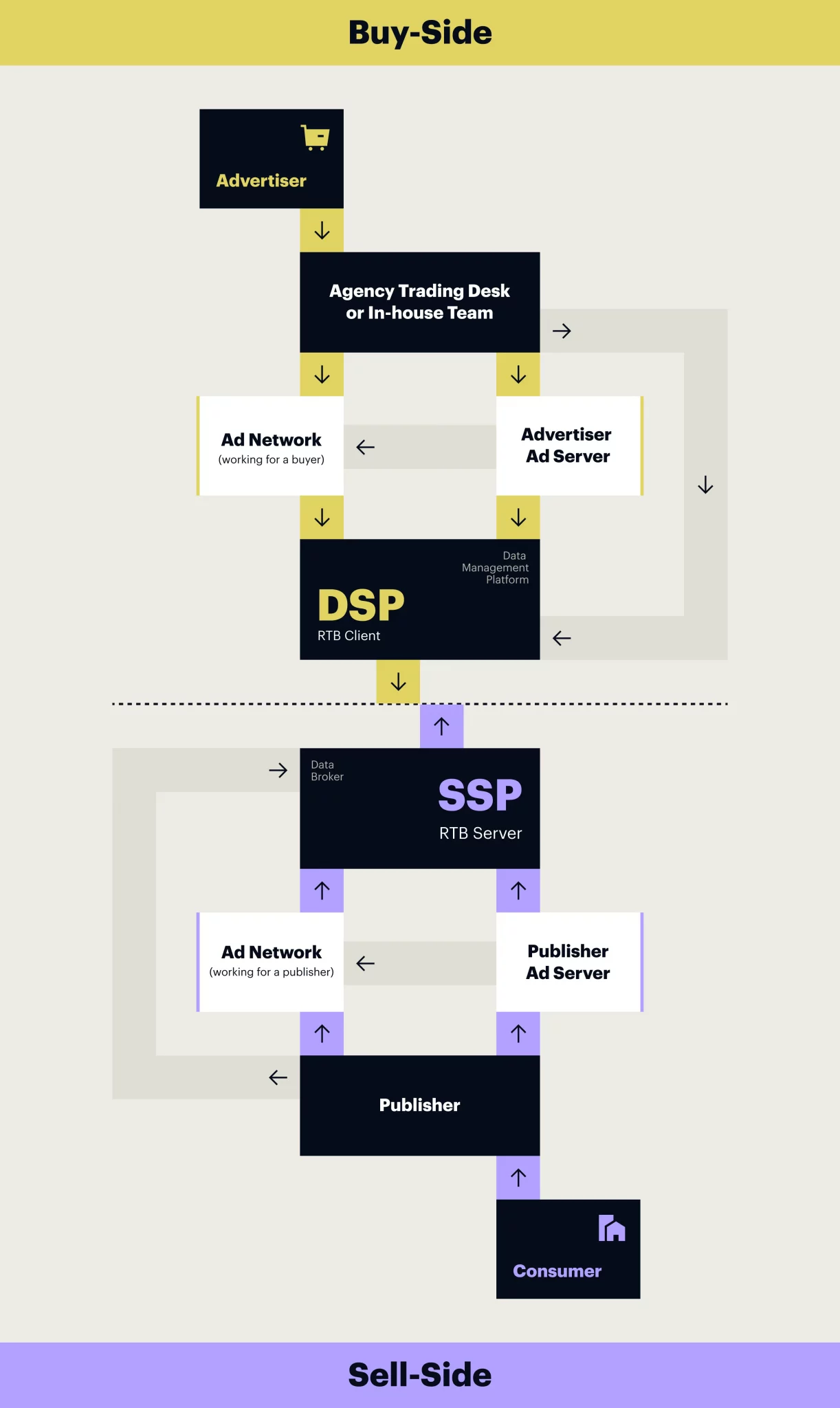
Ad exchanges
Ad exchanges are a critical bridge in the programmatic advertising realm. They are a marketplace where advertisers and publishers connect. Google Ad Manager is the first platform of this kind—it allows advertisers to sell and purchase ad inventory across multiple websites. Plus, it gives marketers assurances that their content will reach their target audience at the right time and price.
Say, a small business looking to advertise its new kitchenware line. With a substantial understanding of how the audience behaves, they can use Google Ad Manager to bid on ad spaces on relevant websites and directly engage with potential customers. Ad exchanges are ideal for maximizing your reach and perfect for publishers looking to sell their ad space to relevant businesses.
The benefits of programmatic advertising
There are good reasons programmatic advertising is so popular and in demand among marketers, as it comes with a bundle of advantages both for team, budget, and performance.
Efficiency
Programmatic advertising saves a lot of time and reduces costs, as it makes tedious and repetitive tasks that previously required human involvement run by themselves.
Targeted Advertising
Programmatic advertising gives you all the tools to approach your audiences on a deeper level with advanced targeting. It ensures that advertisements reach the appropriate users based on age, location, gender, and purchase history. Such precise targeting helps you get more ad click-through rates, and when connected with dedicated landing pages, it translates into more conversions and ROAS.
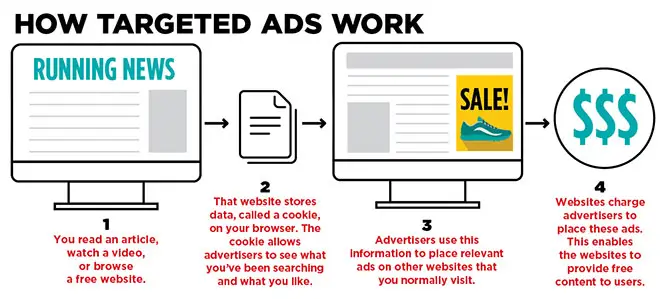
Cost-effectiveness
Programmatic advertising offers flexible budget options, allowing businesses to create ads promoting their products, fostering market inclusivity and healthy competition.
Real-time measurement
Apart from giving you the tools to do well in your current campaign, it also gives you the insights and data to do even better in your next one. Programmatic advertising platforms provide real-time measurable results for campaigns. Keep an eye on these dynamics to continuously refine their ads and drive a higher return on investment. This advantage also includes the budget, as you can identify errors early on and save your advertising dollars on potentially unsuccessful campaigns.
Transparency and reach
Programmatic advertising offers total transparency in the ROAS of campaigns and a larger reach for publishers, making it particularly useful for companies focusing on premium placements and brand safety. Marketers can run background checks on the platform they’re considering to avoid negative associations.
Fraud protection
Real-time analytics and programmatic advertising monitoring also offer fraud protection features. With the transparency it provides, you can check if the ads are served to genuine users, thus preventing ad fraud and, again, wasting budgets. This layer of security alleviates risks and gives marketers peace of mind when collaborating with advertisers.
How to run programmatic ads?
Set campaign goals
The first step in running programmatic ads is to set clear and specific campaign goals. You can aim at increasing brand awareness, driving website traffic, generating leads, or boosting sales. With no clear goals, your campaign does not have a direction to move or ways to measure its success.
Once set, your campaign goals will guide the rest of your programmatic advertising process.It is the starting point for choosing the right platform, creating relevant content, and measuring success.
Choose a programmatic advertising platform
Assess your capabilities and accessibility to choose from Sell-Side platforms (SSPs), Ad Exchanges, and Demand-Side platforms (DSPs). Evaluate each platform’s strengths and consider your budget, target audience, and ad formats to make an informed decision.
Create ad content
When you have picked the platform, you understand what content you need to publish. Thus, this is the step for marketers to be creative. Ensure your content resonates with your target audience and aligns with your campaign goals. Use engaging visuals and compelling copy, and articulate a clear call to action. Your ad content is the primary vehicle through which you communicate with potential customers, so make it count.
Set up the campaign
Define your target audience, set your budget, and schedule your ads. Each platform has its setup process, so carefully following the guidelines is crucial. When all the configurations are finished, you can now launch your campaign.
Launch and monitor the campaign
Track key metrics such as impressions, click-through rates, conversion rates, and return on ad spend, and watch for recurring patterns that impact your campaign performance.
Optimize the campaign
Finally, use your gathered data to tweak your ad content, adjust your targeting, or reallocate your budget. Remember, programmatic advertising is a dynamic process that requires constant testing and optimization to get the best results.
How to measure programmatic advertising results?
Impressions, clicks, and user actions provide the basic framework for assessing your programmatic advertising campaign. However, these are only the initial metrics. To truly assess the effectiveness of your programmatic advertising campaign, measure the key performance indicators (KPIs) aligned with your company’s goals. Use the chart below as a guide for matching your goals and KPIs:
| Goal | KPIs |
| Branding and awareness | Reach/unique reach, impressions, average frequency, share of voice, brand lift, views |
| Interest and consideration | Completed views, clicks/site visits, detail page views, engagements, leads/cost per acquisition |
| Purchase | Return on ad spend (ROAS), return on investment (ROI), sales, subscriptions, advertising cost of sales (ACOS) |
Impressions
An impression is counted each time your ad is displayed to a user, regardless of whether they interact with it. This KPI provides insight into the reach of your campaign and can indicate if your targeting strategy works.
Clicks
Clicks measure the number of times users were interested enough to click on your ads. The KPI shows how engaging your ad content is and gives you an insight into the creative choices in your campaign. A higher number of clicks typically indicates that your ad is compelling and successfully captures user attention.
Click-through rate (CTR)
Click-through rate is the ratio of users who click on your ad to the number of total users who view your ad (impressions). A high CTR indicates that your ad is relevant and appeals to your target audience.
Click-through conversions (CTC)
Click-through conversions measure the number of conversions that occur directly from users clicking on your ads. Track this KPI to understand if your ads are really driving the desired action, such as making a purchase or filling out a form.
Video completion rate (VCR)
Video completion rate, or VCR, measures the percentage of video ads played through their entire duration. A high VCR usually means that your video content is engaging enough to hold the viewers’ attention. Plus, it is another KPI to check your creative choices for the campaign.
Conversions
Conversions are the actions that you want users to take after seeing or clicking your ad. Making a purchase, signing up for a newsletter, or downloading a resource are examples of conversions. Tracking conversions is vital to understanding how effectively your ads drive desired customer actions and what creative or targeting choices are actually effective.
Cost per completed view (CPCV)
Cost per completed view measures how much you pay for each video view that plays through to completion. This metric helps you understand the cost-effectiveness of your video ads.
Cost per acquisition (CPA)
Cost per acquisition (CPA) measures the price you must pay to acquire every new customer through a specific campaign. Monitor your CPA to see your programmatic advertising performance and make data-driven decisions for future campaigns.
Programmatic advertising examples
The Economist: Tickling audience’s curiosity bone

The Economist analyzed subscriber interactions on its website and mobile app to discern attractive content and optimal timing. The publication created audience segments in finance, politics, economics, and technology, among others, and built lookalike audiences from these segments.
The ads reflected the preferences of each segment. The campaign generated over 6 million unique actions, attracted 1 million unique website viewers, and added 9500 new subscribers, and a Channon Prize for Best New Learning on top of that, making it a textbook case study in analytics combined with creativity.
Amanda Foundation: Gamifying pet adoption
Acknowledging differing preferences for cats, dogs, and specific breeds, the foundation used extensive audience targeting to match potential adopters with suitable pets.
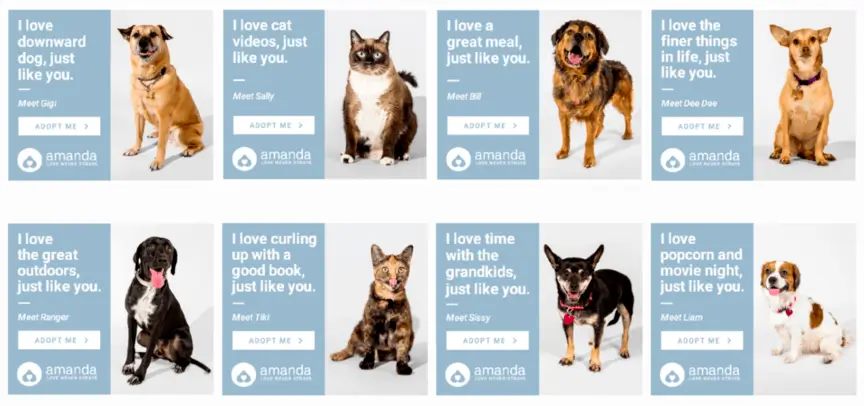
In this campaign, an older individual fond of park visits could be paired with a Golden Retriever, while an outdoor enthusiast might be shown an ad featuring a Labrador Retriever. Although the campaign’s results were not disclosed, its inclusion in many programmatic ad compilations attests to its effectiveness. This is a case study on researching your audience to align products or services with user preferences in ad campaigns.
Spotify: Nobody knows you as your playlist does
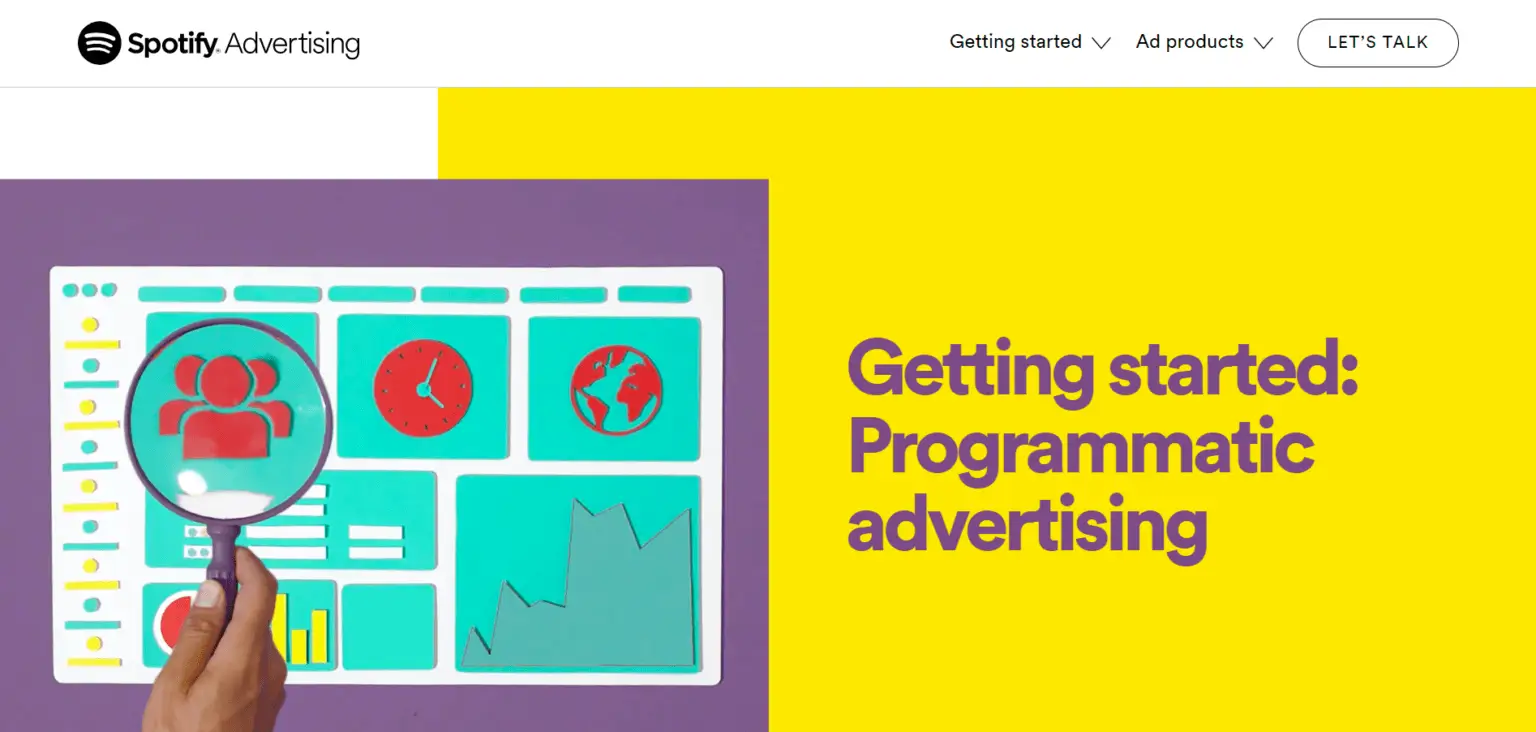
By analyzing user behavior, listening habits, and musical preferences, Spotify crafted ads that resonated with all its audiences. For instance, indie music listeners received ads for relevant festivals and events. This strategic use of data led to an engagement rate 2.5 times higher than the industry average and a 25% increase in ad recall.
The relevance of these targeted ads reduced the cost per acquisition by 20%, enhancing Spotify’s profitability. This campaign stresses the power of personalization in advertising.
Start running programmatic ads to get more conversions
A lot of brands have seen success using programmatic advertising, and you can be one of them. To better navigate the world of programmatic advertising, you need to learn everything you can about an ad exchange before you invest in it, look out for newer buying methods like post-trade programmatic, and consistently review KPI reports to determine whether your ad dollars are being spent the way they should be.
To start capitalizing on the power of personalized advertising, sign up for a 14-day free trial on Instapage today.

Try the world's most advanced landing page platform with a risk-free trial.
